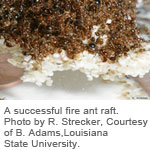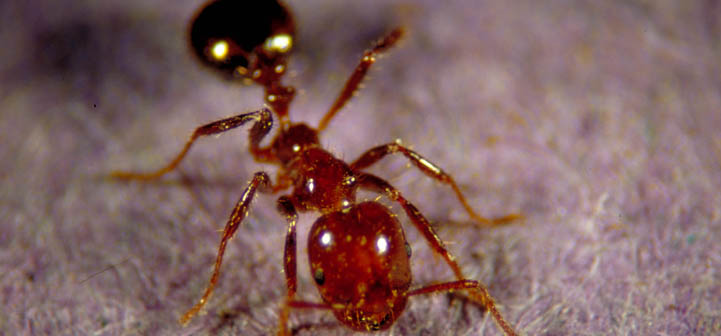 Imported fire ants live in colonies in the soil. If a colony is flooded during a rainstorm or other high-water situation, the ants cling together and form a living raft that floats on the flood waters. Once the raft hits dry ground or a tree, rock, or other dry object, the ants can leave the water.
Imported fire ants live in colonies in the soil. If a colony is flooded during a rainstorm or other high-water situation, the ants cling together and form a living raft that floats on the flood waters. Once the raft hits dry ground or a tree, rock, or other dry object, the ants can leave the water.
A research study published in 2011 determined how the ants stay afloat and maintain the raft.
- As a colony is flooded, ants accumulate on the highest ground and form the raft. The ants tip the raft into the water before they are completely submerged by the flood waters.
- Ants trapped under water collect bubbles from submerged materials and use them to break the surface tension and lift themselves out of the water.
- Worker ants in the raft hang on to each other by holding tarsi (the insect equivalent of hands).
- Workers move around the raft constantly, so no individual ant is submerged for too long.
- The queen(s) is/are kept safe in the middle of the raft.
- Fire ant workers keep the eggs and the tiniest larvae safe by holding them in their mouths.
 Colonies with brood (immature fire ants) are more likely to survive than colonies without brood. Colonies with brood can float in the raft formation for up to 12 days. Rafts with no brood usually sink within hours. Older larvae and pupae are kept at the bottom of the raft, where they help the raft stay afloat. The oldest ant larvae have hairs that are especially effective in holding bubbles.
Colonies with brood (immature fire ants) are more likely to survive than colonies without brood. Colonies with brood can float in the raft formation for up to 12 days. Rafts with no brood usually sink within hours. Older larvae and pupae are kept at the bottom of the raft, where they help the raft stay afloat. The oldest ant larvae have hairs that are especially effective in holding bubbles.
- Winged males are the first to be thrown off the raft.
- In coastal areas, the high salinity of the flood water may reduce the ability of fire ants to form rafts. This may result in a temporary reduction in fire ant populations in areas flooded by saltwater.
- Insect growth regulator baits prevent the queen(s) from laying viable eggs. Therefore, the first effect of treatment with these baits is that treated colonies will not have brood. As this study showed, lack of brood makes these colonies less likely to survive a flooding event. So insect growth regulator baits may be a logical choice during times when flooding is likely to occur, such as during hurricanes. Flood events may actually enhance the effectiveness of applications of insect growth regulator baits.
The following video from the antlabGT YouTube channel demonstrates how hard it is to sink a fire ant raft:
Related Content
Further Reading:
Adams, B.J., L. M. Hooper-Bui, R.M. Stecker, and D.M. O’Brien. 2011. Raft formation by the red imported fire ant, Solenopsis invicta. J. Insect Sci. 11:171 available online: insectscience.org/11.171.
Mott, N. The Ant Raft. http://antlab.gatech.edu/antlab/The_Ant_Raft.html
Find more information about fire ants in eXtension’s Imported Fire Ant Resource Area.
